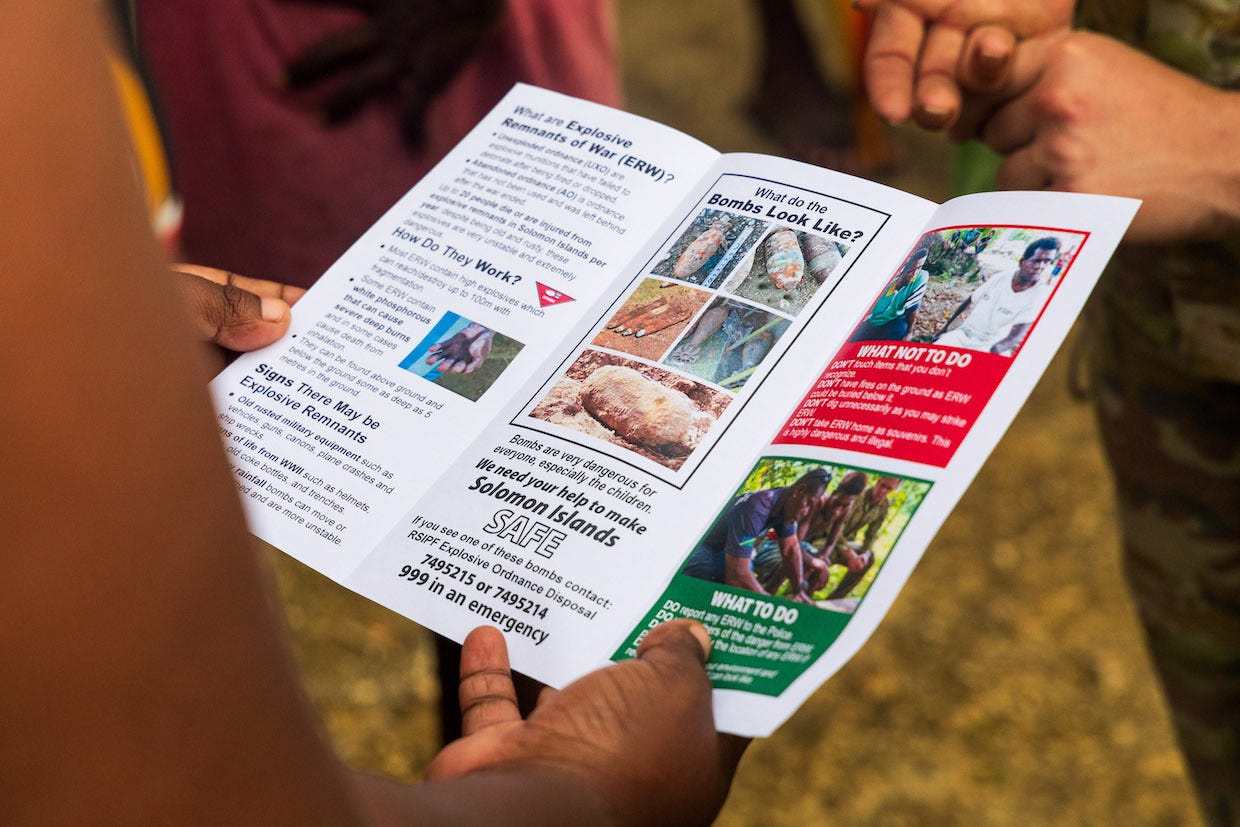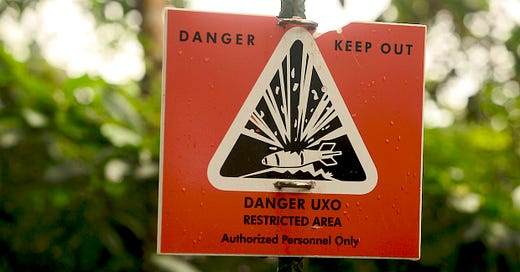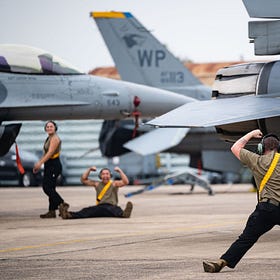Trump aid freeze halts cleanup of decades-old bombs that still kill on former battlefields
US-backed programs to dispose of unexploded bombs in countries around the world have been stopped while Trump officials review all US foreign aid.
BANGKOK — The impact of the Trump administration’s 90-day freeze on foreign aid has rippled out from Washington DC — where thousands of officials and contractors have lost or may soon lose their jobs — to far corners of the world.
Groups that aid migrants in Latin America, support displaced people in Ukraine, and provide medical care in Middle Eastern and African war zones have been told to stop operations while the administration reviews all foreign assistance programs. The directive also affects US-funded programs to remove unexploded ordnance from former battlefields, an acute issue in the Asia-Pacific region, where countries are still dealing with bombs and other weapons left from wars that ended decades ago.
The US, largely through the State Department and the US Agency for International Development, has spent millions of dollars and worked with foreign governments and NGOs to remove aging weaponry — much of it left there by the US military — over the past several decades, but that ordnance still litters beaches, countrysides, and cities, endangering lives and livelihoods.
That the aid freeze comes as US officials warn about threats from China and seek greater military presence in the region is likely to add to concerns there that the US is preparing for another war without addressing the lingering effects of previous ones.
‘America First’

The request to cease removal of unexploded ordnance, or UXO, programs came early on January 25 from Karen Chandler, who leads the State Department’s Office of Weapons Removal and Abatement. In an email obtained by The New York Times, Chandler said the directive was “effective immediately” and “consistent with the president’s executive order on re-evaluating and realigning United States foreign aid.”
Several groups have said they complied with the request. The UK-based Mines Advisory Group said on January 27 that Chandler’s office had asked it to “halt US-funded operations.” Norwegian People’s Aid said in a statement that it had been "instructed by the US Department of State to immediately halt all operations and activities” associated with US funding.
“Consequently,” NPA said, “all US-funded Mine Action and Disarmament activities in the following 12 allies and partner countries of the US, are now put on hold: Afghanistan, Angola, Cambodia, Iraq, Kosovo, Lao PDR, Palau, Peru, Tajikistan, Ukraine, Vietnam, and Yemen.”
NPA and MAG said their work has had “strong bipartisan support,” and MAG said past administrations, including Trump’s, had supported it “because of its alignment with US national interests.” Other groups involved in UXO cleanup have not released statements or have declined to comment on the freeze, likely reflecting concern about scrutiny from an administration that is very critical of foreign aid.
When asked about the halt, a State Department spokesperson said in an email on January 31 that, “We are reviewing all foreign assistance funds to ensure they are aligned with American interests.”
“National security is and will remain a top priority,” the spokesperson said. “The review period is a measure put in place for us to align our ongoing work with the America First agenda.”
‘Transformative’ US contributions

Land mines, unexploded bombs, and other weapons are present on former battlefields around the world, but the problem is pronounced in Pacific Island countries and in Southeast Asia.
In places where fighting between the US and Japan was fiercest during World War II, there could be hundreds of thousands of pieces of ordnance that failed to detonate or were left behind after the war. Decades of inter-state and civil wars in Southeast Asia also subjected those countries to intense bombardment, especially Vietnam, Laos, and Cambodia.
The US dropped more bombs on Laos alone between 1964 and 1973 than on Germany and Japan during World War II, and an estimated one-third of them didn’t go off, according to a 2019 report by the Congressional Research Service, which cited estimates that more than 20% of the land in Cambodia, Laos, and Vietnam was contaminated by UXO and that it would take at least a century to clear it.
Leftover munitions — often unstable after decades of deterioration — continue to affect daily life. US and Japanese bombs are regularly found in Okinawa, disrupting life on an island that still hosts major US bases. In Honiara, the Solomon Islands’ capital, UXO is so prevalent that it hinders installation of utility poles and pipes and cables. In May 2021, two men cooking in a residential area of the city died after a US-made WWII-era artillery shell exploded underneath them; a few weeks later, a man digging a septic system in another part of the city found 101 of the same shells.
In Southeast Asia, unexploded bombs are often found a few inches underground and still kill and maim farmers and other workers as well as adults and children in and around their homes. Land mines and cluster bombs were used extensively during wars in the region and continue to cause harm.
The US is trying to end its 'drought' in Cambodia
When USS Germantown sailed into the port of Sihanoukville in October 2016, the US-Cambodia military relationship seemed strong.
Even trained personnel face risks: In Cambodia, 31 de-mining personnel were killed and 125 injured between 1997 and 2024 — two more were killed in January while clearing a minefield in northwest Cambodia. Two NPA staffers were killed in 2020 when a WWII bomb exploded in their office in Honiara.
The US has been a major supporter of UXO removal. Cooperation on that “was at the forefront of initial post-war reconciliation efforts in Southeast Asia and remains a foundation of the United States’ commitment to regional peace and prosperity,” the State Department said in its most recent report on that funding, published in early 2024.
The report said US funding for UXO removal in Asia-Pacific countries in 2023 totaled more than $87 million and helped clear more than 52 square miles of land, and the Biden administration pledged millions more dollars for those programs during its final months in office.
Since 1993, the top recipients of that funding have been Laos, Vietnam, Cambodia, Thailand, and the Solomon Islands, the report said. “Over the past 30 years, US contributions have not only been significant but transformative,” Ly Thuch, first vice president of the Cambodian Mine and Victim Assistance Authority, said in November.
US support for UXO removal in Pacific Island states has increased in recent years, along with other outreach seen as an effort to counter China’s growing ties with those countries. In the Solomon Islands — where Beijing’s inroads have alarmed American officials — aid jumped from $0 in 2021 to $1 million in 2022 and $3.4 million in 2023.
‘Weapon that never stops killing’

The sudden aid freeze has left those countries in the lurch. Thuch said Cambodia didn’t have funds to replace US aid and that the freeze affected 93 de-mining projects and could leave more than 1,000 people without work.
“As a consequence, the achievements expected by 2025 may be delayed for three months,” Thuch said on January 30.
Vietnam’s ambassador to the US said last year that the two countries had made progress on UXO removal but needed “to speed up the process.” Some now view the freeze as the US shirking its obligation to address the legacies of its wars. “The US government and the American people bear responsibility for addressing the consequences of the war,” a Vietnamese government official told The Times after the freeze was announced.
US and China flex new military muscle in battle for influence in Southeast Asia
The US and China sent new aircraft to exercises in Thailand in 2024, reflecting how both countries are pursuing closer military ties in Southeast Asia.
The US Defense Department also contributes to UXO removal in Southeast Asia and across the Pacific, but the scope of its participation is limited by US law and it’s not clear how much attention it will give to that work going forward. In a message to troops on January 25, Defense Secretary Pete Hegseth stressed that the military’s focus would be on “restoring the warrior ethos,” developing and deploying new weapons, and “deter[ing] aggression in the Indo-Pacific by Communist China.”
The US military has been increasing its training and other preparations for a potential conflict in the Pacific for years now. If that work continues while efforts to clean up from past wars are sidelined, it will likely dismay countries that the US would like to have on its side in a clash with China.
In the Solomon Islands and elsewhere, “World War II continues to kill our people through unexploded ordnances, and therefore the memory of people today about World War II is a weapon that never stops killing,” Tarcisius Kabutaulaka, a professor at the University of Hawai'i Center for Pacific Islands Studies, said in 2023. “I think it's very important that US leaders and US public servants bear that in mind.”






